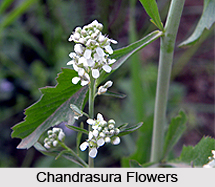 Chandrasura is a medicinal plant of India. It is cultivated as a salad plant throughout India. This plant is also cultivated as a medicinal plant in India and is important for its multiple medicinal properties. The plant is sometimes referred to as "Garden Cress" to distinguish it from similar plants also referred to as cress, is a rather fast-growing, edible herb. Garden cress is genetically related to watercress and mustard, sharing their peppery, tangy flavor and aroma. Edible oil is obtained from the seed. Chandrasura seeds, since ancient times, have been used in local traditional medicine of India.
Chandrasura is a medicinal plant of India. It is cultivated as a salad plant throughout India. This plant is also cultivated as a medicinal plant in India and is important for its multiple medicinal properties. The plant is sometimes referred to as "Garden Cress" to distinguish it from similar plants also referred to as cress, is a rather fast-growing, edible herb. Garden cress is genetically related to watercress and mustard, sharing their peppery, tangy flavor and aroma. Edible oil is obtained from the seed. Chandrasura seeds, since ancient times, have been used in local traditional medicine of India.
Different Names of Chandrasura
The botanical name of this medicinal plant is "Lepidium sativum L". It is commonly known as "Aleveri" in Bengali; "Garden Cress" in English; "Asalio" in Gujarati; "Halim" in Hindi; "Allibija" in Kannada; "Ahliva" in Marathi; "Tezak" in Punjabi; "Chandrasura" in Sanskrit; "Aliverai" in Tamil and "Adeli" in Telugu.
Characteristic Features of Chandrasura
Chandrasura is a small, herbaceous, glabrous annual plant which is 15 cm to 45 cm tall. The leaves of these plants are variable, entire or variously lobed or pinnatisect, often with linear segments. The lower leaves are long-petioled, twice pinnatisect whereas the upper leaves are sessile, linear and oblong. Flowers are small, white in colour with long racemes. The fruits of these medicinal plants are known as pods. These are small, orbicular-ovate, notched at the apex, winged; seeds solitary in each cell. It is in flower from Jun to July, and the seeds ripen from Jul to August. The flowers are pollinated by Insects.

Medicinal Value of Chandrasura
The entire plant is useful for the treatment of asthma, coughs and bleeding piles. Its leaves are stimulant and diuretic, and are useful for treating scorbutic diseases and liver disorders. The roots of Chandrasura plant are used to cure secondary syphilis and tenesmus. The seeds are considered to be emenagogue, laxative, tonic, aphrodisiac and diuretic. They are useful for the treatment of poultices to treat sprains and the mucilage obtained from these seeds help to cure irritation of the intestines in cases of dysentery and diarrhoea.
In Ayurveda practice, the Chandrasura plant is considered as tonic, galactagogue and aphrodisiac, and medicines are prepared for treating dysentery, abdominal pain, blood and skin diseases and tumors. In this type of medical practice, the fruits are suggested for treating skin and eye diseases. Unani is another type of medical department where this Chandrasura plant is very much useful to cure different diseases. Here, seeds are used to treat inflammation and ailments of the spleen, bronchitis, rheumatism and muscular pain, and are believed to improve brain power and brighten the intellect.











